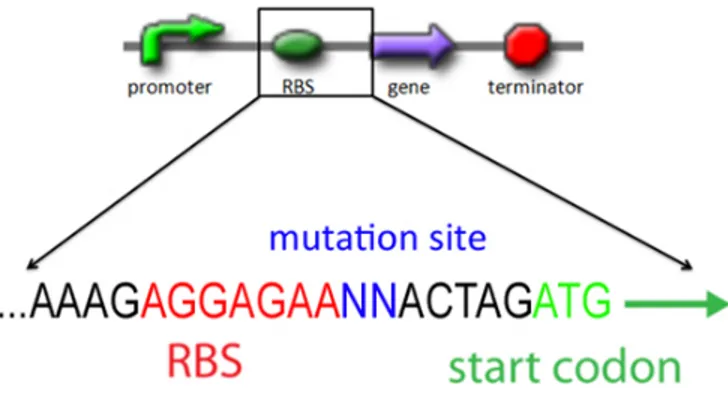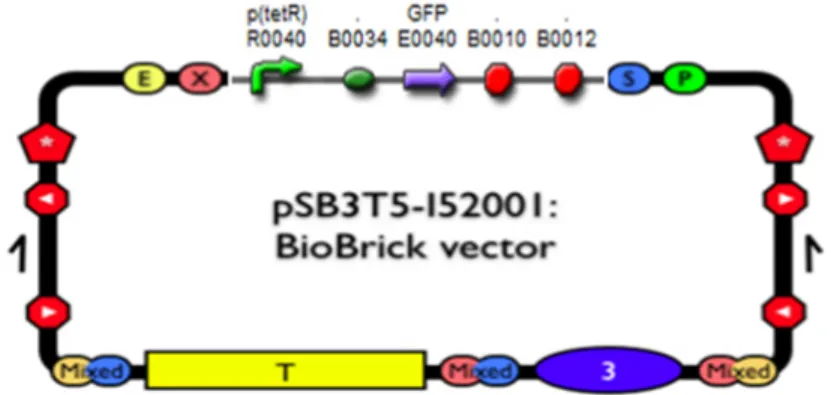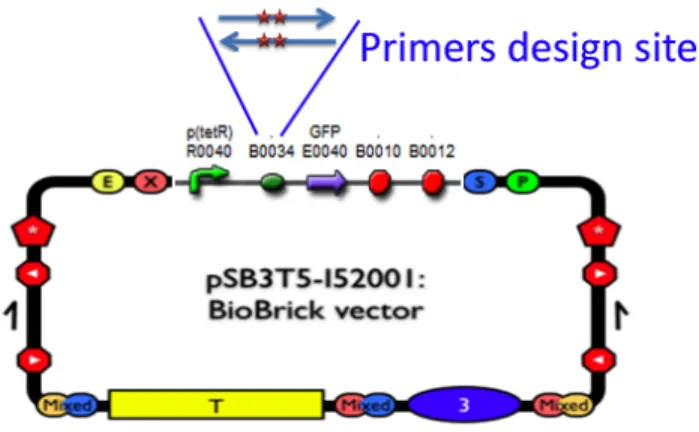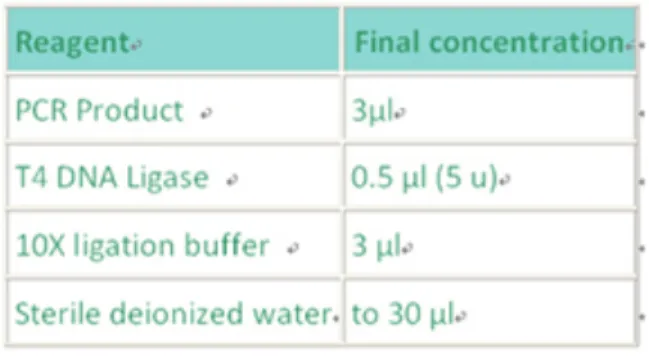BBF RFC 79 <RBS library>
BBF RFC 79: < Construction a RBS library with different
translational activity>
<Hsiao-Ching Lee><2010/10/29>
1. Purpose
The first step in programming and controlling cell behavior is to establish a library of well-defined components, a.k.a. "biobricks", that serve as the building blocks of artificial gene networks. The main challenge in genetic circuit design lies in selecting well-matched genetic components that when coupled, reliably and consistently act in a desired behavior. Although the parameter values are calculated by model equations, it is hard to select the biobricks that reliably implements a desired cellular function with quantitative values. To overcome this problem, the RBSs were designed to control the expression of downstream genes when necessary. This protocol will describe how to generate a RBS library with different ribosome binding affinities. The degenerated primers designed for PCR are used to generate mutations in RBS regions, while the mutated RBS activity are assayed using green fluorescence protein on a low copy number plasmid. In addition, a library of RBS's with different transcriptional strength can be built to fit the specific parameter values derived from model equations. Because the reporter protein activity has a positive correlation to RBS translational activity, we can design customizable RBS translational strengths for application.
2. Relation to other BBF RFCs
This RFC is not related to any other Request for Comments document.
3. Copyright Notice
Copyright (C) The BioBricks Foundation (2010). All Rights Reserved.
4. Principle
The conserved sequence of an RBS is AGGAGAA (red label in Fig.1). Mutations occurring in the nearby region affect RBS translational activity, therefore, by
implementing random mutations in nearby regions, variations in translational activity of the RBSs can be generated.
Fig. 1: The sequence of RBS part BBa_B0034. The conserved sequence is marked in red. The RBS library can be created when the RBS regions are amplified by degenerated primers with some random mutations (blue), then such a library can represent many variations in RBS strength.
5. Protocol
This protocol contains six steps:
1. Construction of standard part to express reporter protein 2. Mutation position(s) selection
3. Degenerated primers design
4. PCR amplification of target plasmid 5. PCR product ligation and transformation 6. RBS activity measurement
(1) Construction of standard part to express reporter protein.
The RBS part (B0034) was selected for RBS point mutation to generate RBS library. This RBS is a component of the pSB-I13522, which is composed of a Ptet promoter, a common RBS (B0034), a reporter gene (GFP gene) and dual Terminators .
The part pSB_I13522 was inserted into the low copy number backbone pSB3T5 to express GFP protein (Fig. 2).
Fig. 2: The part pSB_I13522 was inserted into the low copy number backbone pSB3T5. (2) Mutation position(s) selection
The conserved sequence of RBS is AGGAGAA (Red label in Fig.1 and 3). To prevent the disruption of RBS basic functions, we chose the 2 base pair next to the conserved sequence of RBS for point mutation (Blue label in Fig.1 and 3).
Fig. 3: The sequence of RBS part BBa_B0034. The conserved sequence is marked in red and the point mutation sites in are marked in blue.
(3) Degenerated primers design
The primers containing two base pair mutations were designed as follows (Fig.4). The letter N designate sites containing ATCG bases.
Forward:5'CTAGAGAAAGAGGAGAANNACTAGATGCGTAAAGG3' Reverse:5'CCTTTACGCATCTAGTNNTTCTCCTCTTTCTCTAG3'
Fig. 4: The degenerated primers were designed to amplify the RBS part BBa_B0034. (4) Using PCR to amplify the target plasmid
PCR reaction mixture shown in Table 1. Note, it important to use KOD-plus polymerase. Because DNA polymerase from Termococcus kodakaraensis KOD is one of the most efficient, thermostable PCR enzymes exhibiting higher accuracy and elongation velocity in comparison to other available commercial DNA polymerase, we recommend its use.
PCR condition Table 2
(5) PCR product ligation and transformation
The components of this ligation step are listed in Table 3. When the ligation mixture is prepared, move on to:
(1) Vortex the tube and spin down in a microcentrifuge for 3-5 seconds. (2) Incubate the mixture for 8 hour at 16°C.
Table 3: The components of the ligation mixture. Ligation product is transformed in ECOSTM competent cells. Steps:
1. Thaw competent cells in the room temperature water bath with circulating water or hold the tube under running tap water for ~20 seconds until 1/3~1/2 volume is thawed.
2. Add DNA (pre-chilled on ice, volume should be ≦ 5% of competent cells) immediately. Vortex for 1 second or tap the tube with finger to mix well. 3. Heat-shock the cells in the pre-warmed 42℃ water bath for 30~45 seconds. 4. Plate the cells using plating beads onto a pre-chilled (4℃) and dried antibiotic-
selected LB agar plate. 5. Incubate the plates at 37℃. (6) RBS activity measurement
Bacterial colonies were selected and cultured in M9 medium (with glucose). When bacteria grew to steady-state, 5µL bacterial medium was transferred into a new tube with 5ml M9 medium. Approximately 4-hours after incubation in shaker, the O.D. ratio of the bacterial medium should increase to 0.1, and the sample was measured for green fluorescence activity. All fluorescence measurements were performed on a flow cytometer equipped with a 488 nm argon excitation laser and a 515–545 nm emissions filter.
Fig.5: Green fluorescence intensity of the mutated RBS BBa_B0034. Mutated RBS translational activity from the high (left) to the low state (right).
6. Results and Discussion
For each sample, 100,000 events were collected. A small gate in the side-scatter and forward-scatter space was chosen to reduce the variations in cell size and help remove noise in fluorescence measurements. Fluorescence intensities were converted to molecules of equivalent fluoresces in based on daily measurements of SPHERO Rainbow Calibration Particles. We selected forty different colonies with one wild type colony as our samples and control (the green one in Fig. 6). The final data of green fluorescence activity shows only thirty-eight different data sets as two were later on excluded.
Fig.6: Green fluorescence intensity of colonies with the mutated RBS BBa_B0034. The green one is the wild type colony.
Then we picked eight samples with different GFP expression activity to sequence (labeled in red in Fig. 6). The sequence results are displayed in Fig. 7. Six mutated RBS with different sequences were obtained and translational activity was measured by flow cytometry.
Fig.7: The green fluorescence intensity of colonies with the mutated RBS BBa_B0034. The mutated bases are designated on the bottom.
Additionally, we measured the florescence intensity of each mutant (Fig. 7) during the 7 hours in which the O.D> ration rose to 0.1(Fig. 8). As shown in Fig. 8, there are roughly four different GFP expression level. In 38 mutated samples, four samples with different translational activity were selected. In 37 mutated samples, six samples with different translational activity were selected. The results indicate our protocol can efficiently generate a RBS library with different translational activities.
Fig.8: The green fluorescence intensity of colonies with the mutated RBS BBa_B0034 was measured for seven hours. Mutated bases are shown to the right
7. Conclusion
A protocol has designed a simple and rapid protocol to generate a RBS library. This RBS library with different translational strength can be built to tune the specific parameter values derived from model equations. In summary, the following the steps are took. Degenerated primers designed for PCR are used to generate mutations in RBS regions. The translational activity was then assayed using a reporter protein (GFP). Because the reporter protein activity has positive correlation to RBS activity, we can choose the suitable translational strength of the RBS for our design scheme.
8. Author’s Contact Information
Hsiao-Ching Lee:hsiaoching.lee@gmail.com9. References
1. Howard M Salis, Ethan A Mirsky& Christopher A Voigt(2009) Automated design of synthetic ribosome binding sitesto control protein expression, Nature
biotechnology,27,1038-1438
2. Atsumi, S., Hanai, T. and Liao, J.C. (2008) Non-fermentative pathways for synthesis of branched-chain higher alcohols as biofuels, Nature, 451, 86-89.
3. Elowitz, M.B. and Leibler, S. (2000) A synthetic oscillatory network of transcriptional regulators, Nature, 403, 335-338.
4. Hauf, J., Zimmermann, F.K. and Muller, S. (2000) Simultaneous genomic
overexpression of seven glycolytic enzymes in the yeast Saccharomyces cerevisiae,
Enzyme Microb Technol, 26, 688-698.
5. Martin, V.J., Pitera, D.J., Withers, S.T., Newman, J.D. and Keasling, J.D. (2003) Engineering a mevalonate pathway in Escherichia coli for production of terpenoids,
Nat Biotechnol, 21, 796-802.
6. Peter Smits, H., Hauf, J., Muller, S., Hobley, T.J., Zimmermann, F.K., Hahn-Hagerdal, B., Nielsen, J. and Olsson, L. (2000) Simultaneous overexpression of enzymes of the lower part of glycolysis can enhance the fermentative capacity of Saccharomyces cerevisiae, Yeast, 16, 1325-1334.



